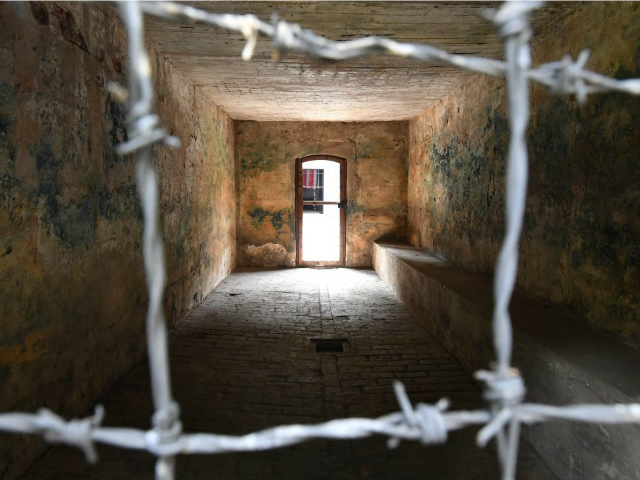The U.S. State Department’s Bureau of Democracy, Human Rights, and Labor released a report on the “Prisons of North Korea” this week. As one might imagine, there is precious little democracy or human rights to be found in the report, but plenty of labor.
The State Department explains North Korea has separate prison systems for its “political” and “re-education” camps, plus a smattering of detention facilities for other purposes.
The political camps separate the “unredeemable” enemies of the state for a life of hard labor. More than one life, actually, because the Communist regime metes out “three generations of punishment” by marching the offender’s family off to labor camps as well, even though they are not accused of a crime.
Those sentenced to die in prison camps include “officials perceived to have performed poorly in their job, people who have criticized the regime, and anyone suspected of engaging in anti-government activities.” That should go a long way toward clearing up Dennis Rodman’s surprise that North Korean citizens speak so highly of dictator Kim Jong-un and his top officials, at least until one of the top officials ends up in a prison camp for performing poorly.
“Economic activities that employ prisoners as slave labor include mining, textiles, farming, and raising livestock. Induced starvation is common among prisoners, who are driven to catch and eat rodents, frogs, and snakes,” the State Department reports. Prisoners forced to work in mining operations are frequently killed.
Male prisoners are “physically punished” for sexual activity at some camps, while females who become pregnant are subjected to forced abortions. In other cases, the camps are better described as prison cities, where entire families are incarcerated together and forced to work as slaves.
Although there is theoretically a penal code system in North Korea capable of meting out punishments less severe than life at hard labor or execution, in practice the State Department believes “revolutionizing zone” prisoners (i.e. those eligible for release) “tend to come from privileged families.”
Some of the information in the report comes from “revolutionizing zone” prisoners who were eventually released, as well as former prison guards. One former guard named Ahn Myong-chol described the prisoners at his camp as a mixture of “walking skeletons, dwarfs, and cripples in rags.” He said somewhere between 1,500 and 2,000 prisoners died every year at that particular prison camp due to malnutrition. Most of the dead were children.
Another leading cause of death at Ahn’s camp was the “punishment chambers” where prisoners were taken for beating and torture. He noted that “prisoners detained in the punishment chambers were often crippled after three months and dead within five months.” The guards were trained not to view prisoners as human. Their training was so effective that the Kim regime eventually told them to tone down the beatings because they were killing too many prisoners. Presumably, the regime was worried about losing too many of its slaves.
Fox News recently interviewed a survivor of one camp who described being “beaten black and blue and tortured constantly,” beginning when he was just a teenager. He said each cell was stuffed with about twenty inmates, who were marched out to perform 14 hours of hard labor each day.
“Cries and screams” were the daily soundtrack of life, to be replaced by “excruciating howls” after midnight—not just from the victims of beatings, and the women dragged off to be raped by guards, but from prisoners who could feel their bodies disintegrating from the combination of malnutrition and labor.
The State Department refers to the U.N. Commission of Inquiry on Human Rights report on North Korea, which the U.N. trenchantly notes was compiled with very little cooperation from Pyongyang. The report found “systematic, widespread, and gross human rights violations,” frequently including outright crimes against humanity.
An entire section of the U.N. report is devoted to “arbitrary detention, torture, executions, and prison camps.” In addition to the horrors chronicled by the State Department, the U.N. report charges the Kim regime with using its brutal prison camps to “forcibly disappear” Christian churches, which the regime sees as threats to its authority.
The abrupt disappearance of victims whisked off to prison without formal accusation or trial is a “deliberate feature of the system that serves to instill fear in the population,” according to the United Nations. The U.N. believes the number of people killed in North Korean prison camps over the past 50 years numbers in the hundreds of thousands.
There is some hope for very modest improvement in the North Korean system, perhaps as a result of international pressure against Pyongyang. The U.N. report notes the Kim regime has a habit of lying about the existence of its prison camps, lapsing into sullen silence when satellite photographs of the camps are displayed.
The State Department found that some of the most notorious camps are evidently being dismantled, while others are being converted into slightly less horrifying quarters for impoverished workers—in essence upgrading them from slaves to indentured servants, which is not much to celebrate.
However, North Korea’s capacity for shame remains extremely limited. Certain camps appear to have been expanded to handle larger populations in recent years. Some of North Korea’s prison camps are the size of cities and patrolled by over a thousand guards.
One especially chilling note from the State Department concerns the Hwasong prison camp, whose inmates may have been forced to work at the Punggye-ri nuclear test site, according to “unconfirmed reports.”

COMMENTS
Please let us know if you're having issues with commenting.